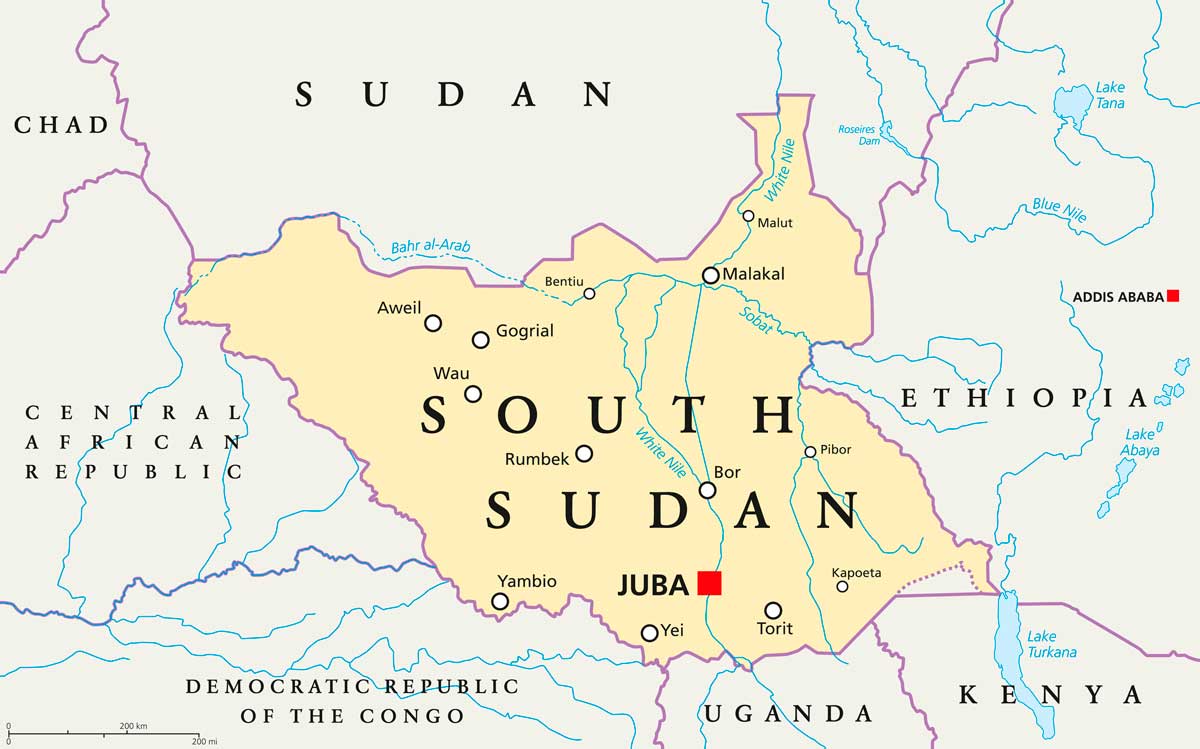South Sudan Map: Regions, Geography, Facts & Figures
South Sudan, officially known as the Republic of South Sudan, is a landlocked country in Africa. It gained independence from Sudan in 2011 after a long civil war. The country is bordered by Sudan to the north, Ethiopia to the east, Kenya to the southeast, Uganda to the south, the Democratic Republic of the Congo to the southwest, and the Central African Republic to the west. The people of South Sudan are known as South Sudanese, and the official language of South Sudan is English, although Arabic and other local languages are also spoken.
If you want to discover more in-depth information on South Sudan as a country, check out our South Sudan Profile!
Plus, test your country knowledge with our African geography quiz, African Flags Part II!

History of South Sudan
South Sudan has a long and complex history, with various ethnic groups and religions, rulers and kingdoms inhabiting this region of the world map for centuries. The country gained independence from Sudan in 2011 after a long and bloody civil war that lasted from 1983 to 2005, spurred by political, ethnic, and economic factors, and a six-day independence referendum. This civil war also resulted in the deaths of an estimated 2.5 million people and the displacement of millions more and has required the involvement of the United Nations.
Geography of South Sudan
South Sudan is located in North Africa and covers an area of 248,777 square miles. The country is mostly flat, with some mountain ranges and hills in the east and southeast. The Nile River, the longest river in the world, flows through the country from south to north. The White Nile and the Blue Nile meet in Khartoum, the capital of Sudan, and continue northwards towards Egypt and the Mediterranean Sea. The Sudd, one of the world's largest wetlands, is located in the country of South Sudan and is an important habitat for wildlife.
States on the South Sudan Map
Like the Republic of Sudan to the north, the political map of Southern Sudan contains several individual states. Major states include Western Equatoria, Central Equatoria, Eastern Equatoria, and the Upper Nile, among others. The Abyei area, in the northern Bahr el Ghazal region, is a contested location still caught between Sudan and South Sudan’s politics, designated by a “special administrative status”.
Tourist Attractions in South Sudan
South Sudan is a relatively new tourist destination and has a lot to offer visitors; however, the country has a high crime rate and continues to experience ongoing conflict and instability, which should be kept in mind.
Some popular tourist attractions in South Sudan include visiting the capital city of Juba, located on the White Nile, which boasts a rich heritage. Visitors can explore the local markets, museums, and restaurants to get a taste of the local culture in this major city.
Other activities include going on a safari in Bentiu to see wildlife; hiking and camping in the scenic city of Bor in the Jonglei region; exploring the historic architecture and cultural heritage of Wau; and experiencing the beautiful scenery and wildlife of Malakal, known for elephants, hippos, and giraffes.
People Also Ask...
If you're inspecting South Sudan maps, you may have some queries about the region. Here are some of the most frequently asked questions, along with their answers.
Why Did Sudan Split Into South Sudan?
Sudan split into two countries, Sudan and South Sudan, in 2011. The split was largely due to ethnic and religious tensions between the Muslim-dominated north and the predominantly Christian and animist south, as well as disputes over resources and political power.
Which Country Does South Sudan Belong To?
South Sudan is a country in East-Central Africa that gained independence from Sudan in 2011 after years of conflict. It is the world's newest country and has faced significant challenges since its independence, including ongoing violence and political instability.
Is South Sudan Still at War?
South Sudan has been in a state of deep unrest in recent years, with fighting between government forces and opposition groups causing significant violence, displacement, and humanitarian crises. Despite efforts to end the conflict, violence has continued in various parts of the country in recent years, though the war has officially ended.
|
|








